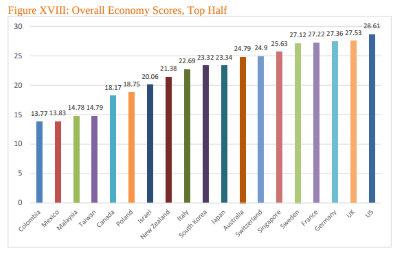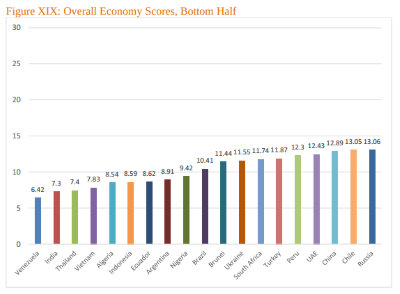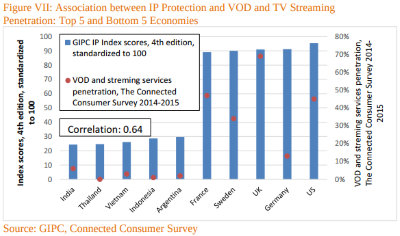 In February, the U.S. Chamber of Commerce released an international intellectual property report entitled Infinite Possibilities which assesses the strength of the IP environment in terms of legislative, administrative and regulatory concerns for nations across the globe. This fourth edition of the international IP report investigates the IP systems of 38 different countries representing 85 percent of the world’s gross domestic product. The report includes an index scoring nations on 30 different indicators related to those countries’ environments for patents, copyrights, trademarks, trade secrets, enforcement and international treaties.
In February, the U.S. Chamber of Commerce released an international intellectual property report entitled Infinite Possibilities which assesses the strength of the IP environment in terms of legislative, administrative and regulatory concerns for nations across the globe. This fourth edition of the international IP report investigates the IP systems of 38 different countries representing 85 percent of the world’s gross domestic product. The report includes an index scoring nations on 30 different indicators related to those countries’ environments for patents, copyrights, trademarks, trade secrets, enforcement and international treaties.
 The United States took the top spot in this version of the Chamber’s international IP index with a score of 28.61 out of a possible 30. The U.S. is closely followed by England, Germany, France and Sweden, each of which have a index score greater than 27. Despite this top score, the Chamber’s report notes that weak U.S. enforcement related to trade secret theft and counterfeit seizures has the country ranked fifth in enforcement. The U.S. also lost a potential half-point on its index score due to narrowing patentability for innovations related to computer-implemented methods and biotechnologies based on recent Supreme Court decisions in cases like Myriad, Mayo and Alice.
The United States took the top spot in this version of the Chamber’s international IP index with a score of 28.61 out of a possible 30. The U.S. is closely followed by England, Germany, France and Sweden, each of which have a index score greater than 27. Despite this top score, the Chamber’s report notes that weak U.S. enforcement related to trade secret theft and counterfeit seizures has the country ranked fifth in enforcement. The U.S. also lost a potential half-point on its index score due to narrowing patentability for innovations related to computer-implemented methods and biotechnologies based on recent Supreme Court decisions in cases like Myriad, Mayo and Alice.
The report noted key areas of strength for the American IP environment, including effective trade secret protection, commitment to international treaties, mechanisms for pharmaceutical-related patent and generally appropriate boundaries set by courts on copyright exceptions. Along with narrowing patentability and weak enforcement against counterfeit products, key weaknesses for the U.S. included ambiguity regarding the obligations of Internet service providers (ISPs) to respond to trademark-holder notices of infringement and the need to speed up information sharing between rights holders and border agents to aid in the identification of infringing goods.
The United Kingdom earned an index score of 27.53 in the latest international IP index, a full point less than the U.S. but enough to place it second out of the 38 countries surveyed. This most recent score is a slight dip from the 27.61 that the country earned in the previous edition of this index. The country has a good enforcement score, thanks in no small part to the establishment in 2013 of a specialist IP crime unit in the City of London’s police force, a unit which focuses much of its work on preventing online sales of counterfeit physical goods. Another notable strength was the 2015 rollout of Creative Content UK, a program designed in cooperation with content creators and ISPs to e-mail warnings to households which persistently engage in the online piracy of movies and music. Incentives for investing in research and development were bolstered by the British government in 2013 with the establishment of tax breaks for development in life sciences and other IP-intensive industries. The index took a negative view of recent legislation in Britain regarding the plain packaging of tobacco products, which it saw as severely limiting the use of branding and trade dress on retail packaging and setting a negative precedent for IP policy.
Germany places third with an index score of 27.36, a roughly similar score to those earned by the country in previous IP indices. Unlike the United States and the United Kingdom, Germany does not have a perfect score on membership in international treaties owing to the country’s inability to ratify the Patent Law Treaty to this point. Historically low damages awards from infringement cases were cited as another key weakness in Germany’s IP environment. The report does note broad online copyright protections and recent policy statements from the German government reaffirming a need to strengthen existing measures for targeting online infringement; eliminating the advertising income of websites hosting infringing content has been discussed although legislation remains to be drafted. Other positives in the German IP environment include an advanced national system with sector-specific IP rights and legal measures which address the unauthorized use of trademarks.
Canada placed 15th overall with an index score of 18.17, leaving it near the bottom of the top half of countries surveyed for the international index. This latest index score is an increase from the 17.92 posted by the country in the third edition of the chamber’s international IP report. Like Germany, Canada’s score is hampered by the country’s inability thus far to ratify and implement international treaties including the Trans-Pacific Partnership (TPP); Canada’s score would also increase with implementation of the Comprehensive Economic and Trade Agreement (CETA) currently undergoing legal review between Canadian and European governments. Other weaknesses include a lack of a takedown mechanism in the country’s ISP notification system and limited eligibility and enforcement mechanisms for patents, especially for those related to life sciences and pharmaceuticals. Strengths to the Canadian IP regime include the recent introduction in 2015 of a 70-year term for copyright protections, clear patentability for computer-implemented inventions and new border controls providing ex officio authority to the country’s custom officials.
 China is the only one of the BRIC nations to increase its score in each of the Chamber of Commerce’s international IP indices, yet it still comes in with a low overall index score of 12.64, albeit an improvement from 12.4 in the last edition of the index. The increased score reflects a positive movement in the civil enforcement environment, according to the report, but delayed measures regarding copyright amendments for high-value live broadcasts and trade secret protection reform hurt the country’s index score. China’s IP strengths include new dedicated IP courts in the cities of Beijing, Shanghai and Guangzhou, improved availability of damages in copyright and patent infringement cases and the demonstrated ability to launch nationwide campaigns against counterfeit products and piracy activities in some sectors. Key national weaknesses include a high rate of trade secret theft, failures in stopping the growth of online counterfeiting, rules requiring foreign entities to share knowledge before entering the country’s market and non-transparent investigations of foreign businesses under the country’s Anti-Monopoly Law.
China is the only one of the BRIC nations to increase its score in each of the Chamber of Commerce’s international IP indices, yet it still comes in with a low overall index score of 12.64, albeit an improvement from 12.4 in the last edition of the index. The increased score reflects a positive movement in the civil enforcement environment, according to the report, but delayed measures regarding copyright amendments for high-value live broadcasts and trade secret protection reform hurt the country’s index score. China’s IP strengths include new dedicated IP courts in the cities of Beijing, Shanghai and Guangzhou, improved availability of damages in copyright and patent infringement cases and the demonstrated ability to launch nationwide campaigns against counterfeit products and piracy activities in some sectors. Key national weaknesses include a high rate of trade secret theft, failures in stopping the growth of online counterfeiting, rules requiring foreign entities to share knowledge before entering the country’s market and non-transparent investigations of foreign businesses under the country’s Anti-Monopoly Law.
Mexico, our North American neighbors to the south, saw its index score take a sizable hit in this latest edition of the international IP report, dropping from 14.55 points in the report’s 3rd edition to 13.83 in the latest one. The index report noted little activity on copyright, online piracy and counterfeiting issues, as well as a growing inconsistency in how pharmaceutical patents are enforced. Mexico also has a poor international treaty score that could be increased by adopting the IP standards of the TPP. The chamber’s IP report does note strengths including the fair and transparent use of compulsory licensing, the use of licensed software in government agencies, signing of the WIPO Internet Treaties and the validation of broadcast copyrights in amendments made in 2014 to broadcast retransmission rules. Weaknesses include a lack of protections for trade secret violations, no exclusive rights for well-known but unregistered trademarks, ineffective border measures and lack of a sufficient framework that promotes action against online piracy.
 Overall, the report finds a strong link between the number of researchers involved in a country’s R&D sector and the level of IP protection enjoyed within that country. The report also includes figures related to how strong IP protections affect the penetration of certain technologies into those countries. For instance, countries with a higher index score typically saw more penetration of video-on-demand (VOD) and streaming television services; countries above the median index score typically had such home entertainment technologies available to 30 percent of its population while those below the median score only saw a 9 percent rate of availability. Interestingly, Germany remains an outlier in this technological field; its low rate of VOD and streaming services penetration is chalked up to a national preference for public broadcasting, according to the report.
Overall, the report finds a strong link between the number of researchers involved in a country’s R&D sector and the level of IP protection enjoyed within that country. The report also includes figures related to how strong IP protections affect the penetration of certain technologies into those countries. For instance, countries with a higher index score typically saw more penetration of video-on-demand (VOD) and streaming television services; countries above the median index score typically had such home entertainment technologies available to 30 percent of its population while those below the median score only saw a 9 percent rate of availability. Interestingly, Germany remains an outlier in this technological field; its low rate of VOD and streaming services penetration is chalked up to a national preference for public broadcasting, according to the report.

![[IPWatchdog Logo]](https://ipwatchdog.com/wp-content/themes/IPWatchdog%20-%202023/assets/images/temp/logo-small@2x.png)

![[[Advertisement]]](https://ipwatchdog.com/wp-content/uploads/2023/01/2021-Patent-Practice-on-Demand-1.png)
![[Advertisement]](https://ipwatchdog.com/wp-content/uploads/2024/04/Artificial-Intelligence-2024-REPLAY-sidebar-700x500-corrected.jpg)
![[Advertisement]](https://ipwatchdog.com/wp-content/uploads/2024/04/Patent-Litigation-Masters-2024-sidebar-700x500-1.jpg)

![[Advertisement]](https://ipwatchdog.com/wp-content/uploads/2021/12/WEBINAR-336-x-280-px.png)
![[Advertisement]](https://ipwatchdog.com/wp-content/uploads/2021/12/2021-Patent-Practice-on-Demand-recorded-Feb-2021-336-x-280.jpg)
![[Advertisement]](https://ipwatchdog.com/wp-content/uploads/2021/12/Ad-4-The-Invent-Patent-System™.png)






Join the Discussion
No comments yet.